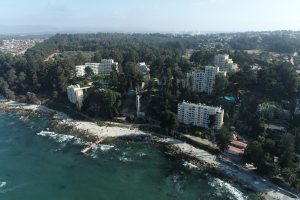Although this change represents progress for the country, specialists from the Observatory of the Coast warn that it is necessary to move towards a Law that establishes clear rules for the protection and public domain of the marine-coastal zone.
Ricardo Acevedo Zalaquett, Journalist.- After almost three decades of applying an erroneous concept that has led to numerous conflicts and threats to coastal ecosystems -now exacerbated due to climate change-, the National Commission for the Use of the Coastal Edge decided this Thursday to adopt the ecosystem approach and replace the concept of “coastal edge” for “coastal zone”.
During the session, chaired by the Undersecretary for the Armed Forces, Galo Eidelstein, and which included the participation of representatives of other ministries and State bodies, it was unanimously approved to work around four axes: ecosystem approach, general interest, coastal zone and strengthening inter-institutional coordination.
Carolina Martínez, director of the Observatory of the Coast, explains that the National Policy for the Use of the Coastal Edge (PNUBC), which dates from 1994, was formulated on the basis of a restrictive definition of the coastline based on the Civil Code, limiting the coasts up to the beach line or, in the best of cases, up to 80 meters from public land (if any).
“The coast constitutes a much broader ecosystem and rich in biodiversity than the beach line considered in that policy, which is why it was urgent to be able to reconsider that definition, so that an integrated management of this fragile and unique ecosystem is possible,” says the academic from the UC Institute of Geography.
The “coastal edge”, he adds, was literally a legal invention that was made almost three decades ago, which does not exist in any other country in the world and is useless to face the serious threats posed by beach erosion and the loss of large areas. of coastal ecosystems.
According to specialists, although this change represents a great advance to achieve an integrated management of coastal areas in our country, it is necessary to move towards a Coastal Law that establishes clear rules for the protection and public domain of the common natural assets of the marine zone. coastal.
One of the issues that the update of the National Policy does not resolve, for example, is the public domain of coastal territories. This domain is prevented, because the PNUBC has the character of regulation and not of Law, for which article 594 of the Civil Code of Andrés Bello prevails, which dates from 1855. This establishes the character of national good for public use of the beaches, but only as far as “where the waves arrive at the highest tides”.
“The coast has a public character that must be protected, it is not just a raw material to be used and occupied. The scientific concept also goes hand in hand with ancestral uses that coastal indigenous communities have given to the coast. Being able to reconcile the various uses that occur in these territories requires a Coastal Law like the one we are currently promoting in Parliament,” concludes Carolina Martínez.
It should be noted that the countries that have managed to better adapt to climate change have successful coastal governance models, including coastal laws where the public domain is recognized for beaches, wetlands and dunes. This is the case of the State of California, USA, which approved its “Coastal Act” in 1976, recognized worldwide as one of the most efficient management programs: after almost 50 years, California’s coastal economy exceeds 40 thousand million dollars annually.
Spain, for its part, did the same in 1988, with the approval of a Coastal Law, which delimited the assets that should be considered for public maritime and terrestrial use: it includes the maritime terrestrial zone, beaches, dunes, wetlands, cliffs, the territorial sea and the natural resources of the economic zone and continental platform. As in the previous case, this Law has been successfully applied for decades.




![[Img #74662]](https://thelatestnews.world/wp-content/uploads/2024/12/Organisms-with-the-shortest-life-150x150.jpg)








![[Img #74662]](https://thelatestnews.world/wp-content/uploads/2024/12/Organisms-with-the-shortest-life-300x200.jpg)

